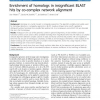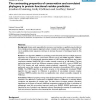140 search results - page 21 / 28 » PIR-ALN: a database of protein sequence alignments |
BMCBI
2006
13 years 7 months ago
2006
Background: Recent progress in cDNA and EST sequencing is yielding a deluge of sequence data. Like database search results and proteome databases, this data gives rise to inferred...
ISMB
1994
13 years 9 months ago
1994
Wepresent the prototype of a software system, cMledGeneQuiz,for large-scale biological sequence analysis. The system was designed to meet the needs that arise in computational seq...
BMCBI
2010
13 years 7 months ago
2010
Background: Homology is a crucial concept in comparative genomics. The algorithm probably most widely used for homology detection in comparative genomics, is BLAST. Usually a stri...
BMCBI
2008
13 years 7 months ago
2008
Background: Amino acids responsible for structure, core function or specificity may be inferred from multiple protein sequence alignments where a limited set of residue types are ...
BMCBI
2007
13 years 7 months ago
2007
Background: The analysis of microarray experiments requires accurate and up-to-date functional annotation of the microarray reporters to optimize the interpretation of the biologi...


